Affiliate links on Android Authority may earn us a commission. Learn more.
Benchmark session: How fast is the Qualcomm Snapdragon 845?
February 12, 2018
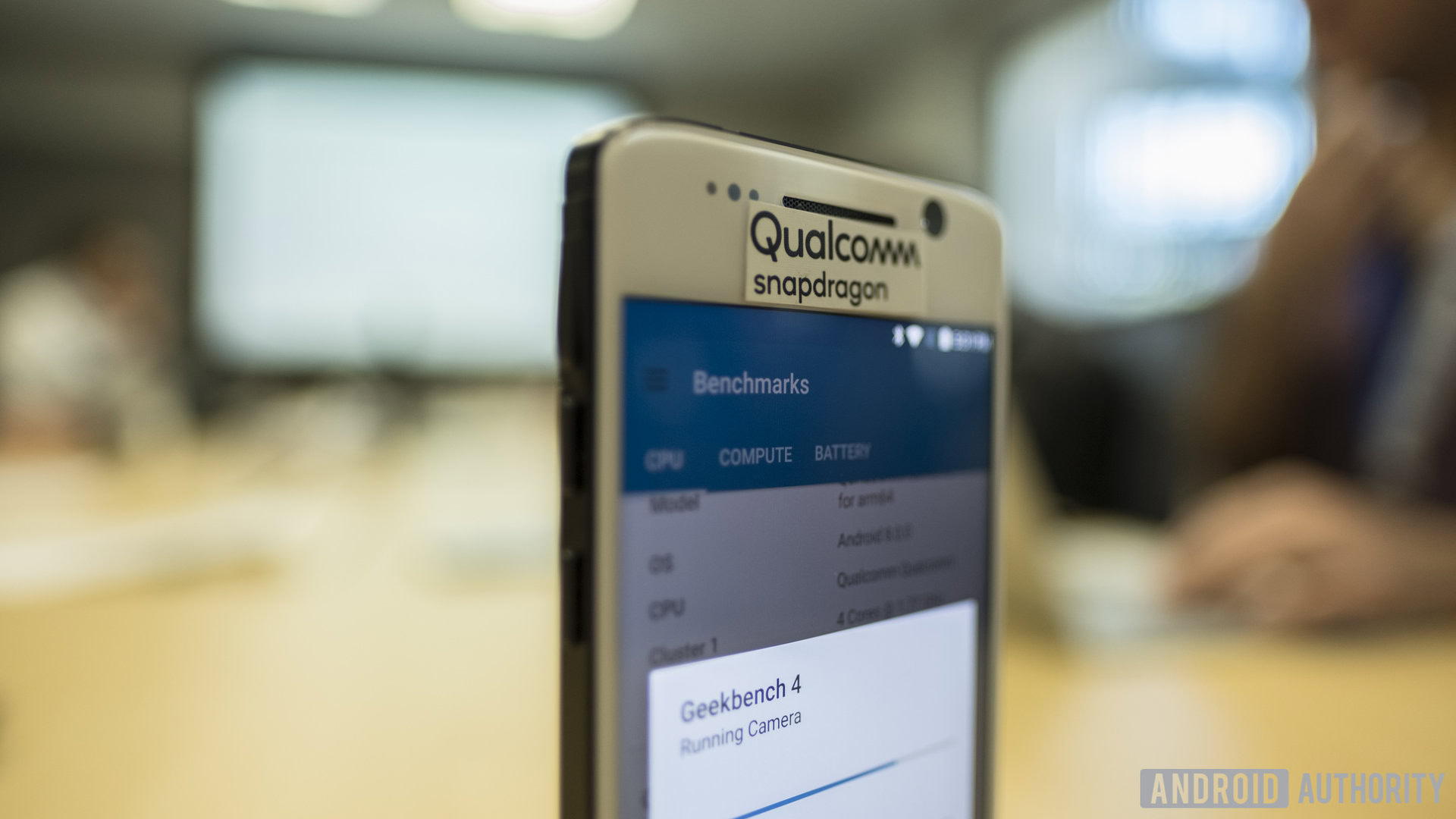
With each new smartphone cycle comes one certainty — a new round of processors, each promising faster performance and better graphics than ever before. While processors from Qualcomm, Samsung, and HUAWEI power most of the smartphones on the market, one company’s SoCs are often adopted by most OEMs.
Qualcomm’s Snapdragon range has become synonymous with powering almost all smartphones on the market, while Exynos and Kirin processors are primarily used in Samsung and HUAWEI smartphones. Hence, major upgrades to the Snapdragon architecture have widespread repercussions for the smartphone industry.
At the end of last year, Qualcomm introduced its new Snapdragon 845 processor in Hawaii. Earlier this week, we were in San Diego to find out just how much faster the 845 is compared to the competition. The first Snapdragon 845 devices aren’t expected to hit the market for another month or so, but Qualcomm let us put the 845 through its paces in the Qualcomm Reference Device.
How fast is the Snapdragon 845? What can we expect from devices powered by the latest and greatest from Qualcomm this year? Here’s what we found.
The Qualcomm Reference Device
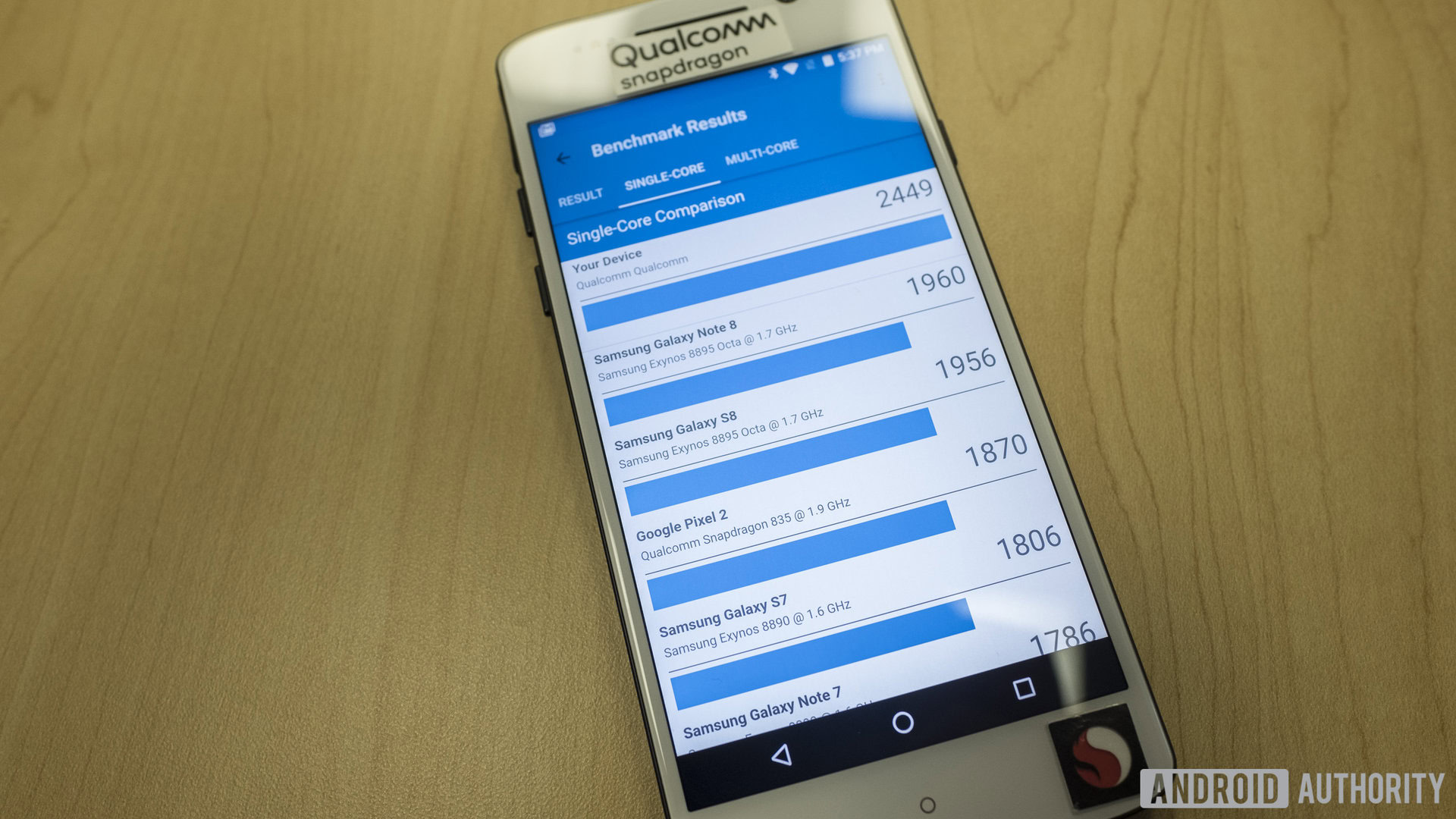
Before we can get into the actual performance testing using synthetic benchmarks, let’s take a look at the specs of the Qualcomm Reference Device. Although this isn’t an actual production smartphone, it’s indicative of the likely production devices that will run the Snapdragon 845.
| Device | Processor | GPU | RAM |
|---|---|---|---|
| Device Qualcomm SD845 Ref | Processor SD845 (4x Kryo 385 @ 1.77 GHz + 4x Kryo 385 @ 2.8 GHz) | GPU Adreno 630 | RAM 6 GB |
| Device HTC U11 Plus | Processor SD835 (4x Kryo 280 @ 1.9 GHz + 4x Kryo 280 @ 2.45 GHz) | GPU Adreno 540 | RAM 6 GB |
| Device LG V30 Plus | Processor SD835 (4x Kryo 280 @ 1.9 GHz + 4x Kryo 280 @ 2.45 GHz) | GPU Adreno 540 | RAM 4 GB |
| Device Pixel 2 | Processor SD835 (4x Kryo 280 @ 1.9 GHz + 4x Kryo 280 @ 2.35 GHz) | GPU Adreno 540 | RAM 4 GB |
| Device Galaxy Note 8 | Processor Exynos 8895 (4x Cortex-A53 @ 1.7 GHz + 4x M2 @ 2.3 GHz) | GPU Mali-G71 MP20 | RAM 6 GB |
| Device Mate 10 Pro | Processor Kirin 970 (4x Cortex-A53 @ 1.8 GHz + 4x Cortex-A73 @ 2.4 GHz) | GPU Mali-G72 MP12 | RAM 6GB |
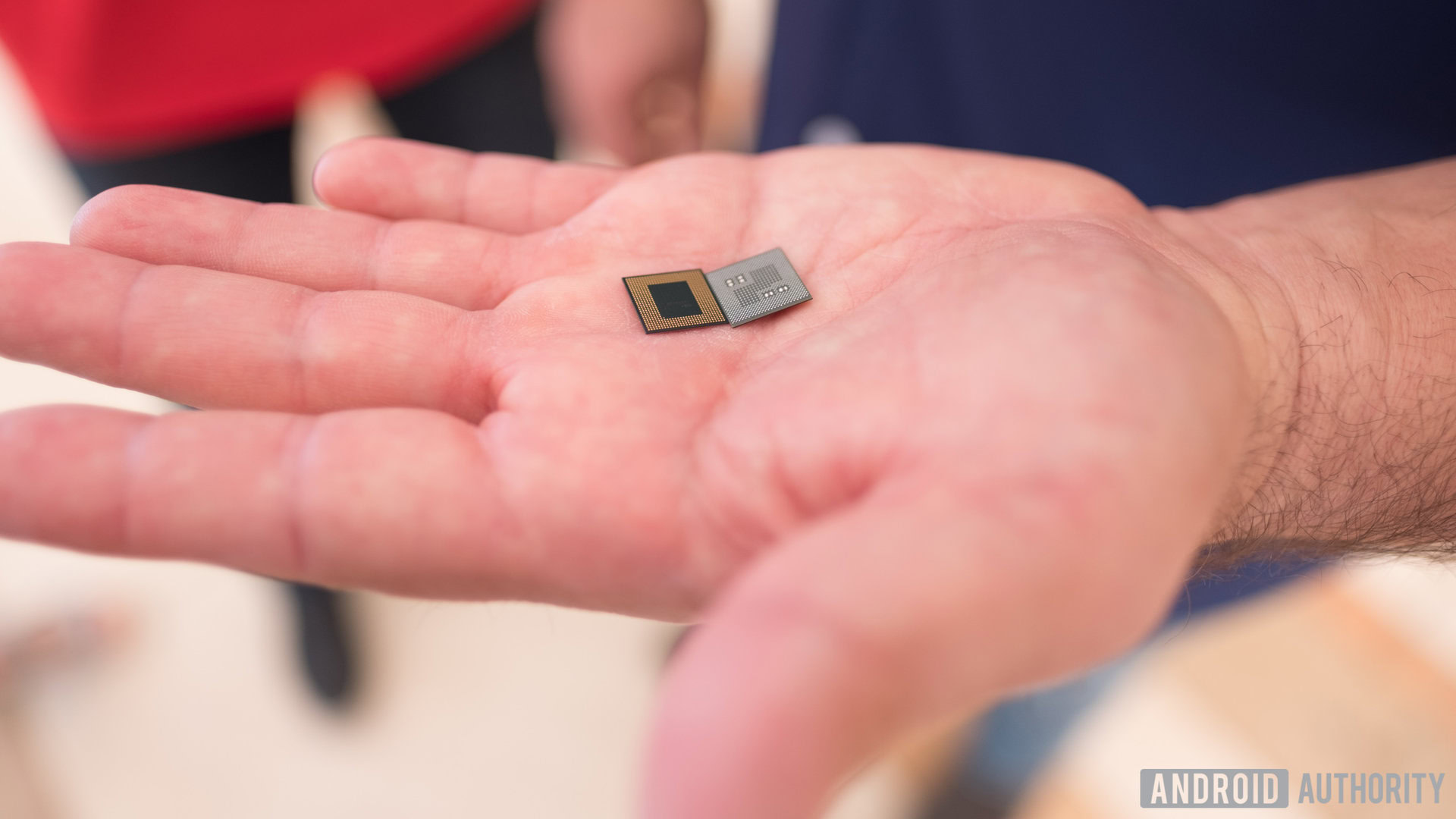
To find out how good the Qualcomm Snapdragon 845 processor is, we need to revisit the processors of 2017 and the flagship devices running these state-of-the-art chipsets. To accurately compare these, we picked the HTC U11 Plus, LG V30 Plus and Pixel 2 which are powered by the Qualcomm Snapdragon 835, as well as the Galaxy Note 8 and HUAWEI Mate 10 Pro which are powered by the Exynos 8895 and Kirin 970 processors, respectively.
The benchmarks
Benchmarks may not be the most reliable test of how fast a processor is, but they can be good indicators of what we can expect from Qualcomm’s latest chipset. To test the Snapdragon 845, we picked a series of the most popular benchmarks that test everything from the CPU and memory to the GPU and web browsing performance.
AnTuTu
AnTuTu is arguably one of the best places to start for any benchmark rundown as it is not only one of the most popular benchmarks, but also offers a single, simple measurement covering everything from the CPU to GPU rendering, storage speed, RAM bandwidth, and much more.
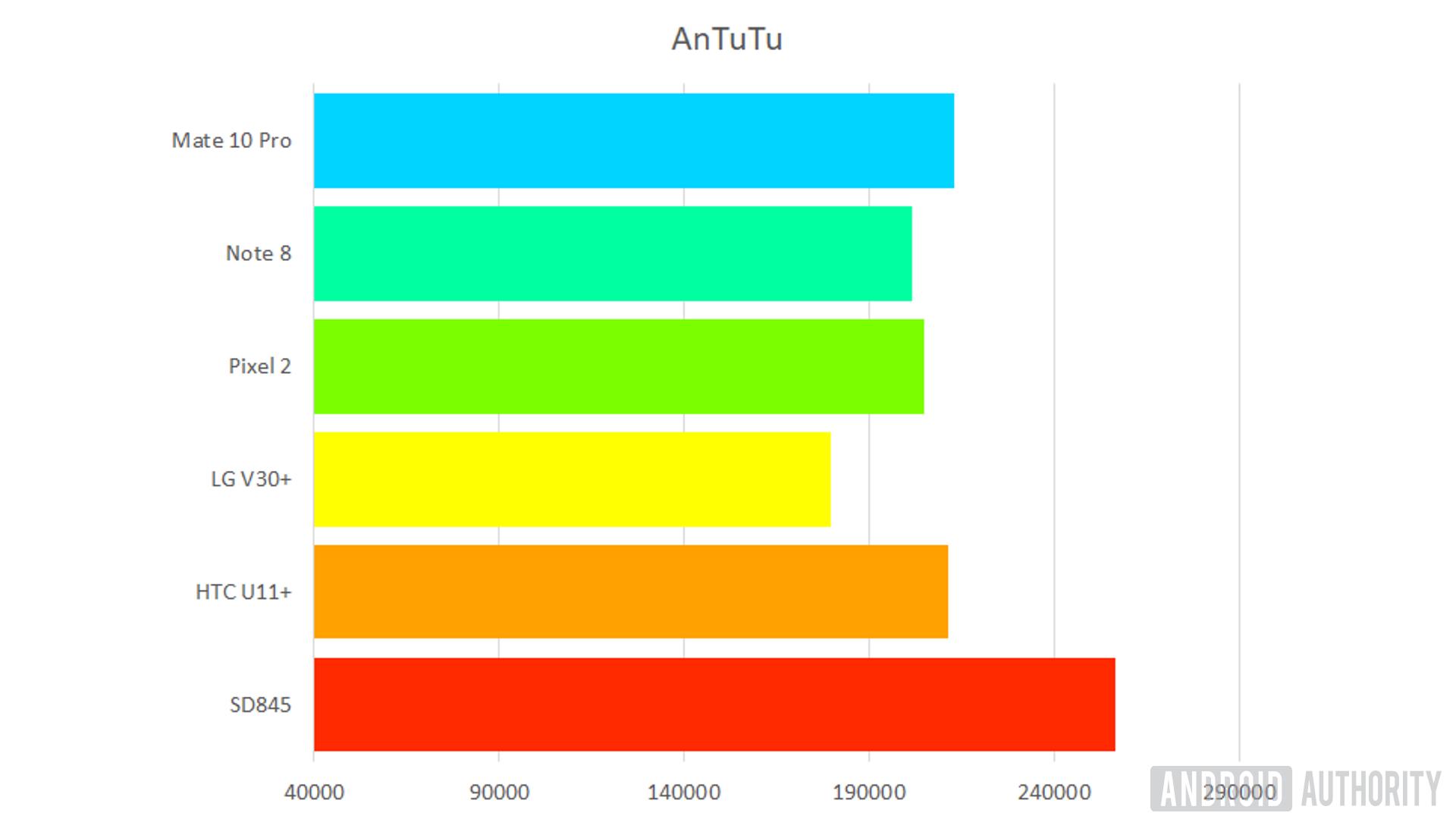
In our testing, the Snapdragon 845 scored an average score of 256805 in AnTuTu’s test. Of the comparison devices from last year, the HUAWEI Mate 10 Pro scored the highest at 212835, while the HTCU11 Plus was the best Snapdragon 835 device with a score of 211381.
Using AnTuTu as a reference point, the Snapdragon 845 proved to be 20.65% better than the Mate 10 Pro, and a whopping 27.07% better than the average of all the processors from last year.
GeekBench 4
GeekBench 4 is another well-known benchmarking tool and scores devices based on processing speed. The CPU results are split into two results, with one number representing the performance of a single core and the other showing the performance of the full multi-core analysis.
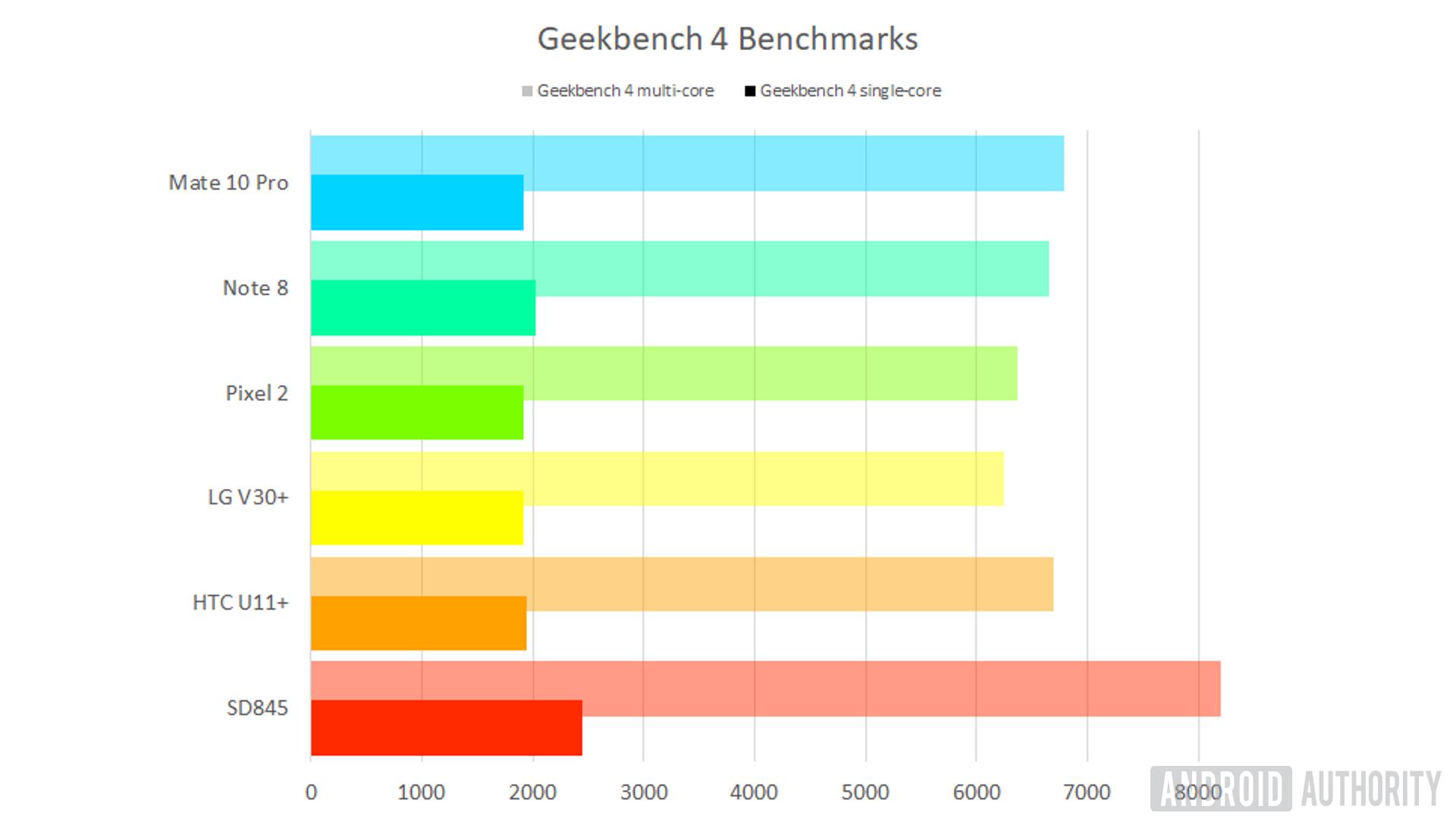
In the single core test, the Snapdragon 845 scores 2439, versus the highest of the rest which was the Exynos 8895 with a score of 2019. The highest Snapdragon 835 device was the HTCU11 Plus which scored 1940, although all the Snapdragon 835 devices ranked around this mark. Using this as a reference, the Snapdragon 845 is 20.80% faster than the Exynos 8895 and 25.73% faster than the average of all of last year’s processors.
In the multi-core test, we see a similar range of improvements. The Snapdragon 845 scored 8200, versus the HUAWEI Mate 10 Pro which was the previous highest with 6787. The best Snapdragon 835 device was the HTCU11 Plus with 6688 although, unlike the single-core test, there was a much wider range of scores for the Snapdragon 835 devices. Using this as a reference point, the Snapdragon 845 is 20.82% better than the Mate 10 Pro and 25.20% better than the average of last year’s chipsets.
GFXBench
GFXBench is a high-end graphics benchmark that covers a variety of industry-standard APIs. To achieve the frame rate scores for each device, we ran a total of four high-intensity off-screen tests — the OpenGL ES3.1 and ES3.0 based Manhattan, as well as the T-Rex and Car Chase. Although we’d traditionally run the onscreen tests to take account for each phone’s screen size and resolution and simulate real world usage as much as possible, we ran the off-screen tests as the Qualcomm Reference Device isn’t an actual phone that’s in production.
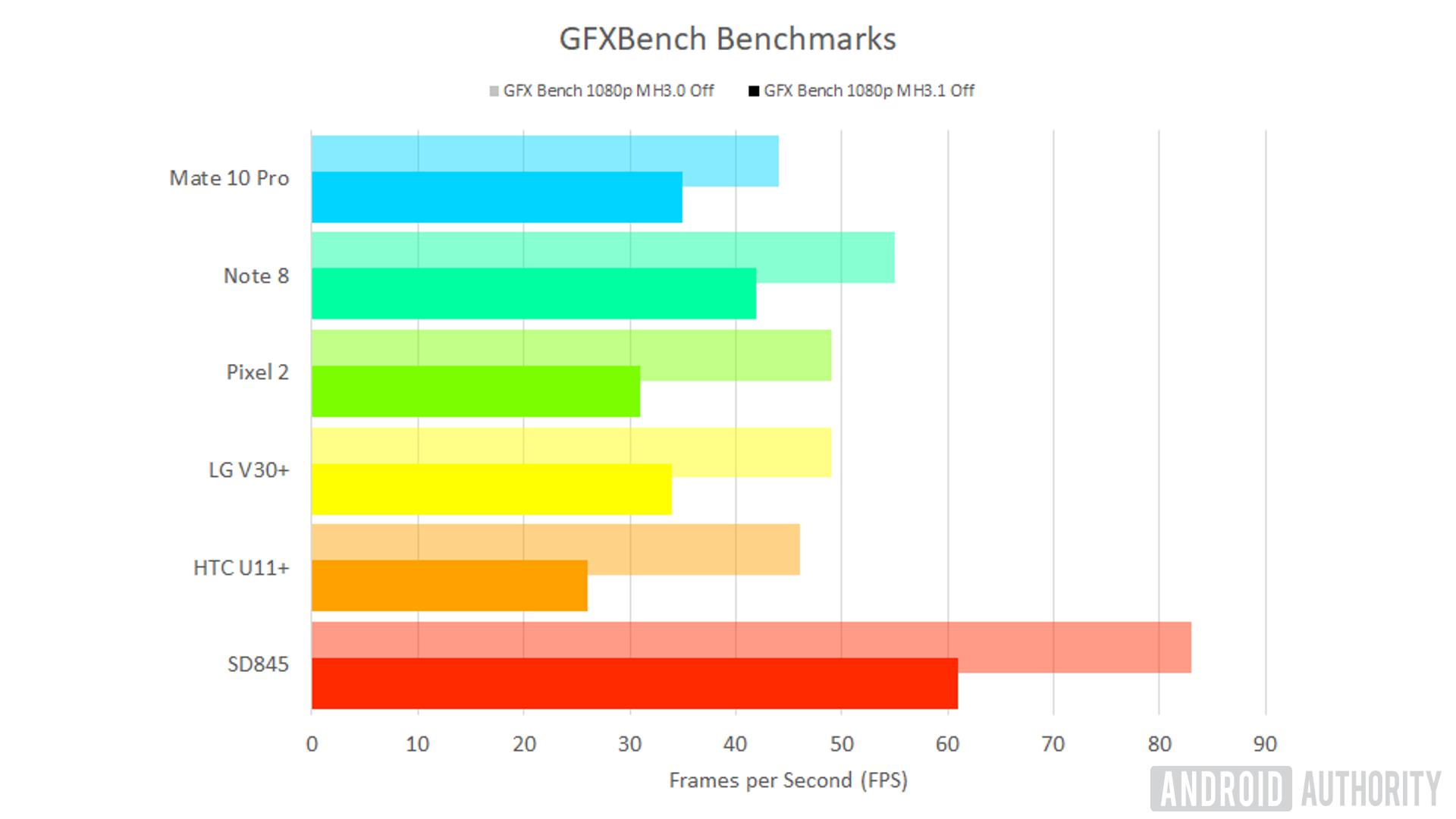
In the first two tests, which use the OpenGL ES3.1 and ES3.0 versions of the Manhattan off-screen test, we found the Snapdragon 845 scored 61 fps and 83 fps, respectively. The best of the rest was the Exynos 8895 in the Galaxy Note 8 which scored 42 fps and 55 fps, while the best Snapdragon 835 device was the LG V30 Plus with 34 fps and 49 fps. As such, the Snapdragon 845 is 45.24% and 50.91% better than the best of last year, and 81.55% and 70.78% better than the average of all of last year’s devices.
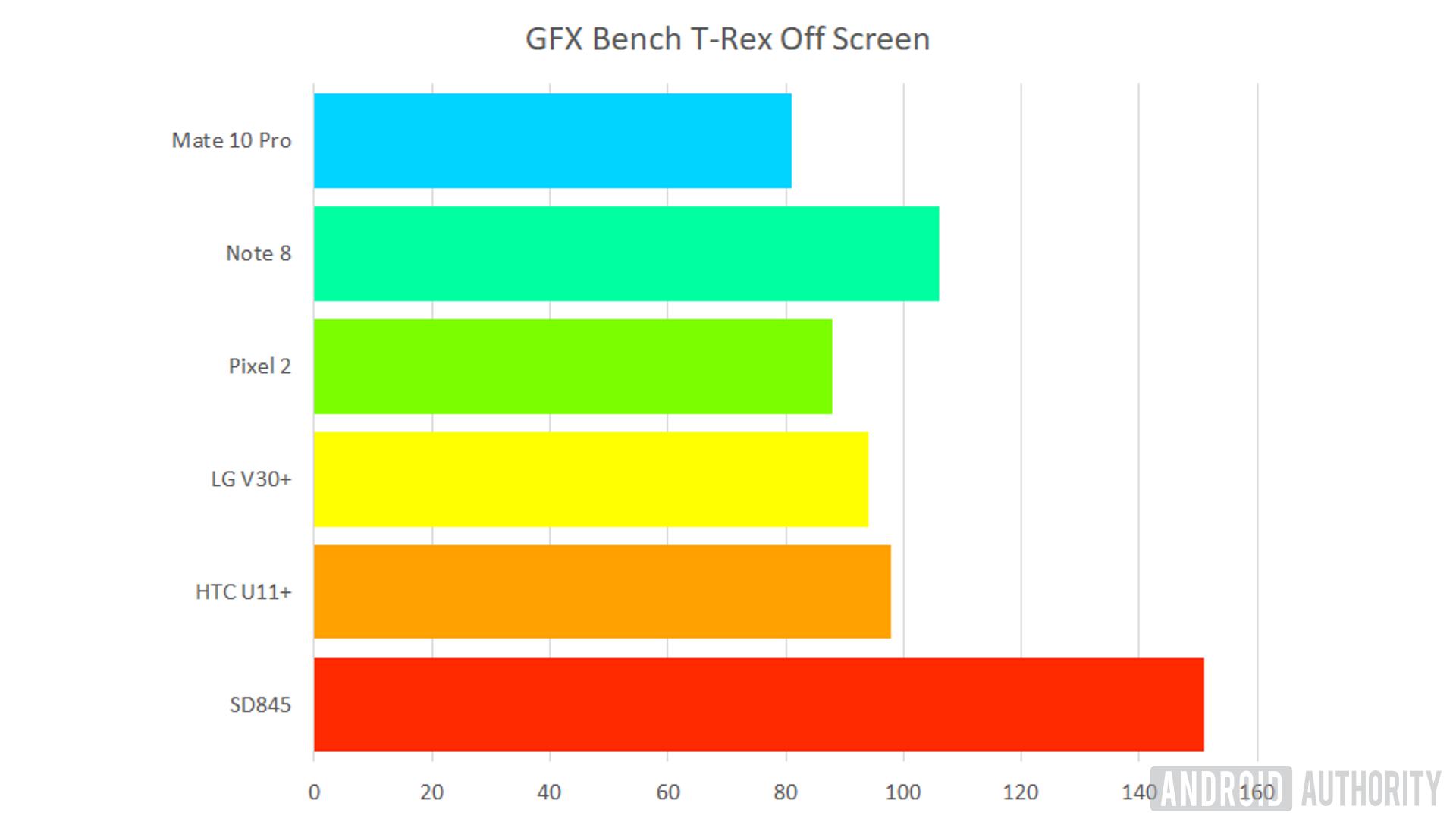
In these two tests, the Snapdragon 845 scored 151 fps in the T-Rex off-screen test and 35 fps in the Car Chase off-screen test. By comparison, the best processor of last year was again the Exynos 8895 with 106 fps and 25 fps, respectively, while the HTCU11 Plus proved to be the best Snapdragon 835 device with 98 fps and 23 fps respectively. Taking these figures into account, the Snapdragon 845 appears to be 42.45% and 40% better than the Exynos 8895, and 61.67% and 59.09% better than the average of last year’s processors.
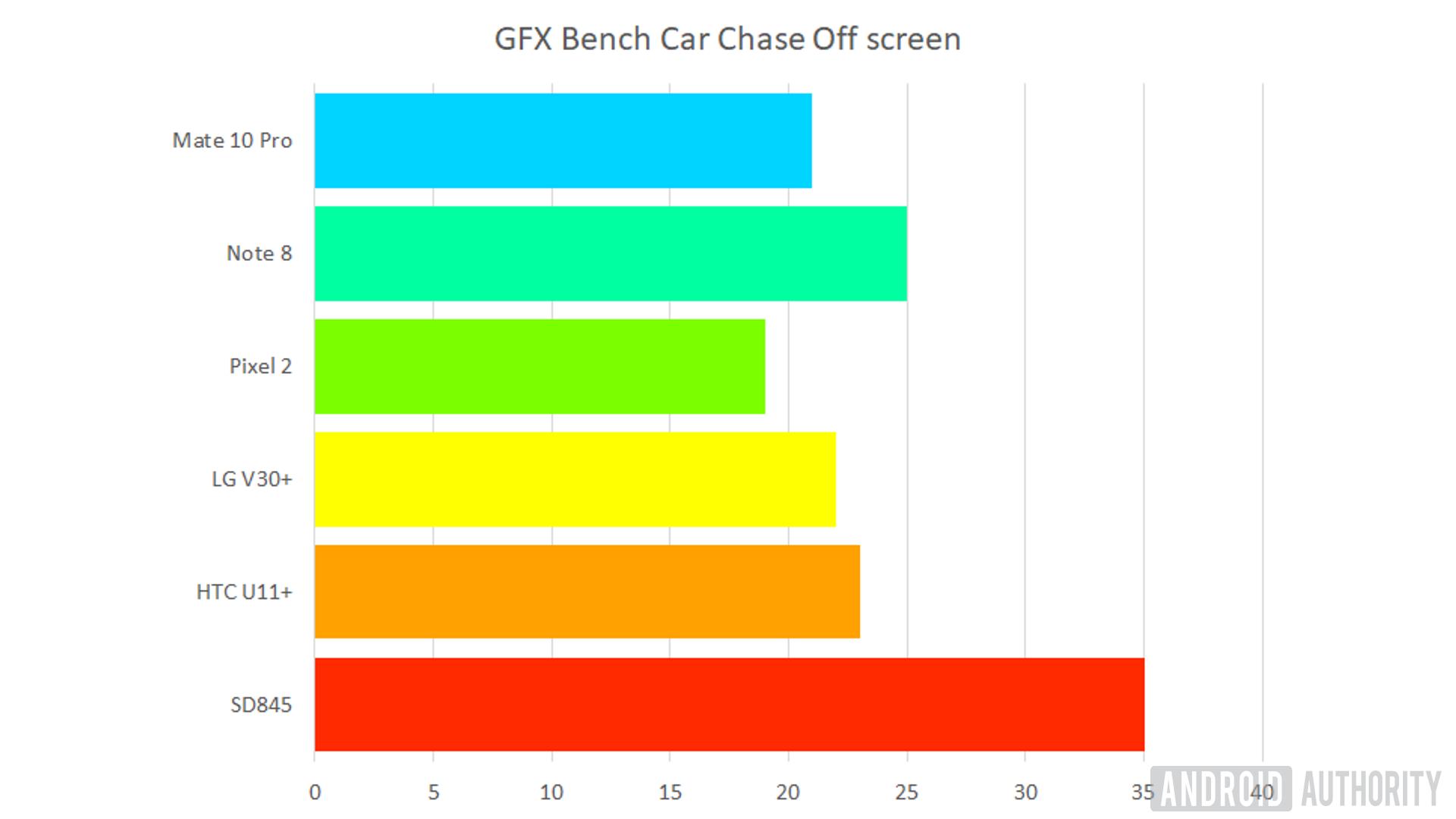
JetStream (Chrome)
JetStream is a JavaScript benchmark test suite that is designed to indicate the performance of a processor in advanced web applications via latency and throughput tests. It is renowned for a comprehensive testing method that covers a variety of advanced workloads and programming techniques to create a single, overall score.
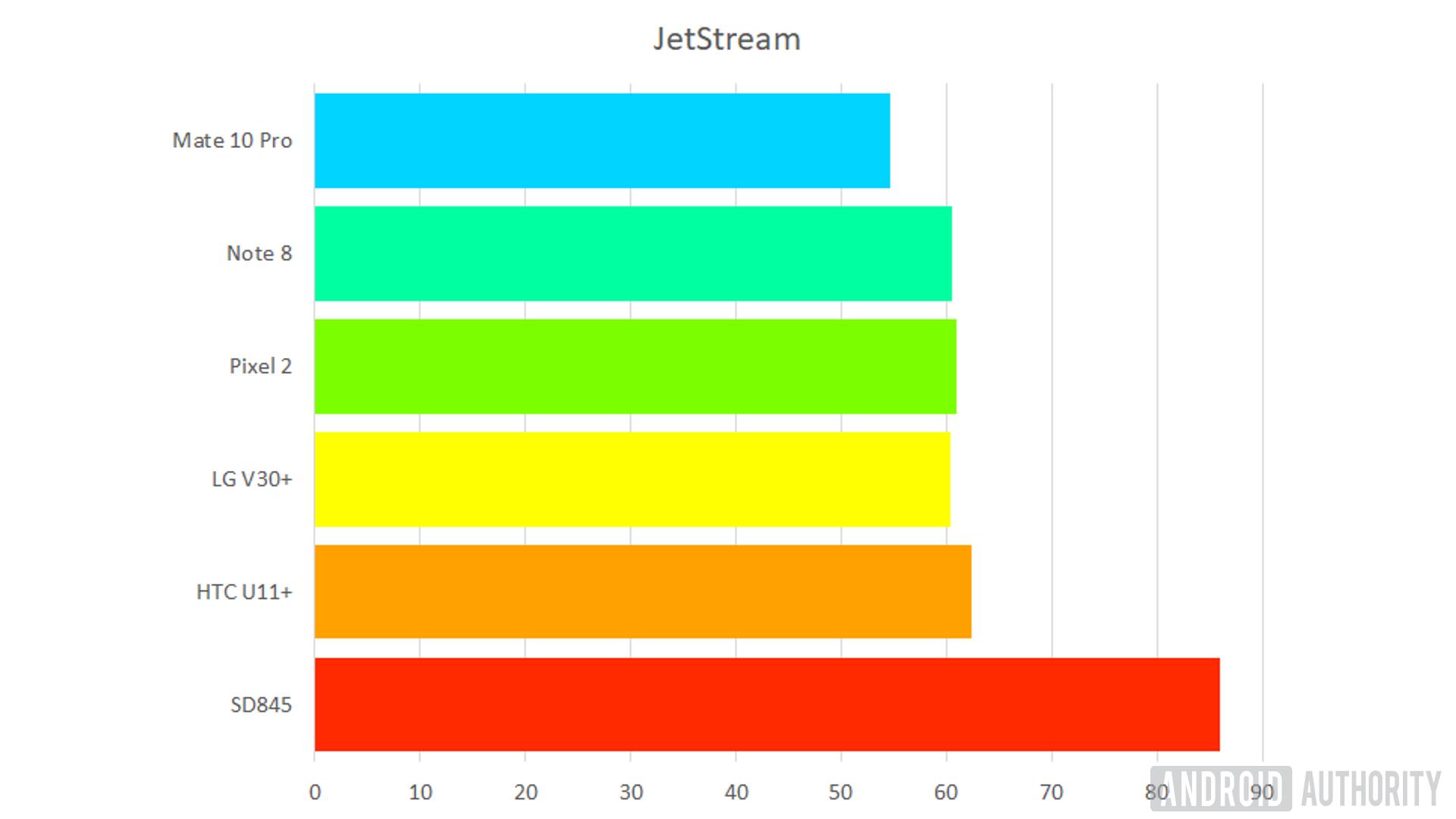
In this test, the Snapdragon 845 scored 85.99, which is 38% better than the HTCU11 Plus, which achieved the second-highest score of 62.31. The Snapdragon 845 proved to be 43.93% better than the average of last year’s processors, which was a score of 59.75.
3DMark
Our Qualcomm Reference Device was running a beta version of 3DMark with the Slingshot Unlimited test, which isn’t available on the current version of the app in the Play Store. Because of this, we used the Slightshot Extreme test for last year’s devices. Because of this, we’re not able to place as much trust in these scores as the other benchmarks. However, 3DMark is a valuable test of graphics processing, so we wanted to include them for reference.
Our 3DMark test is split into two different sets of results: the first takes a look at the OpenGL ES3.1 test, while the second takes a look at the overall result of the OpenGL ES3.0 test.
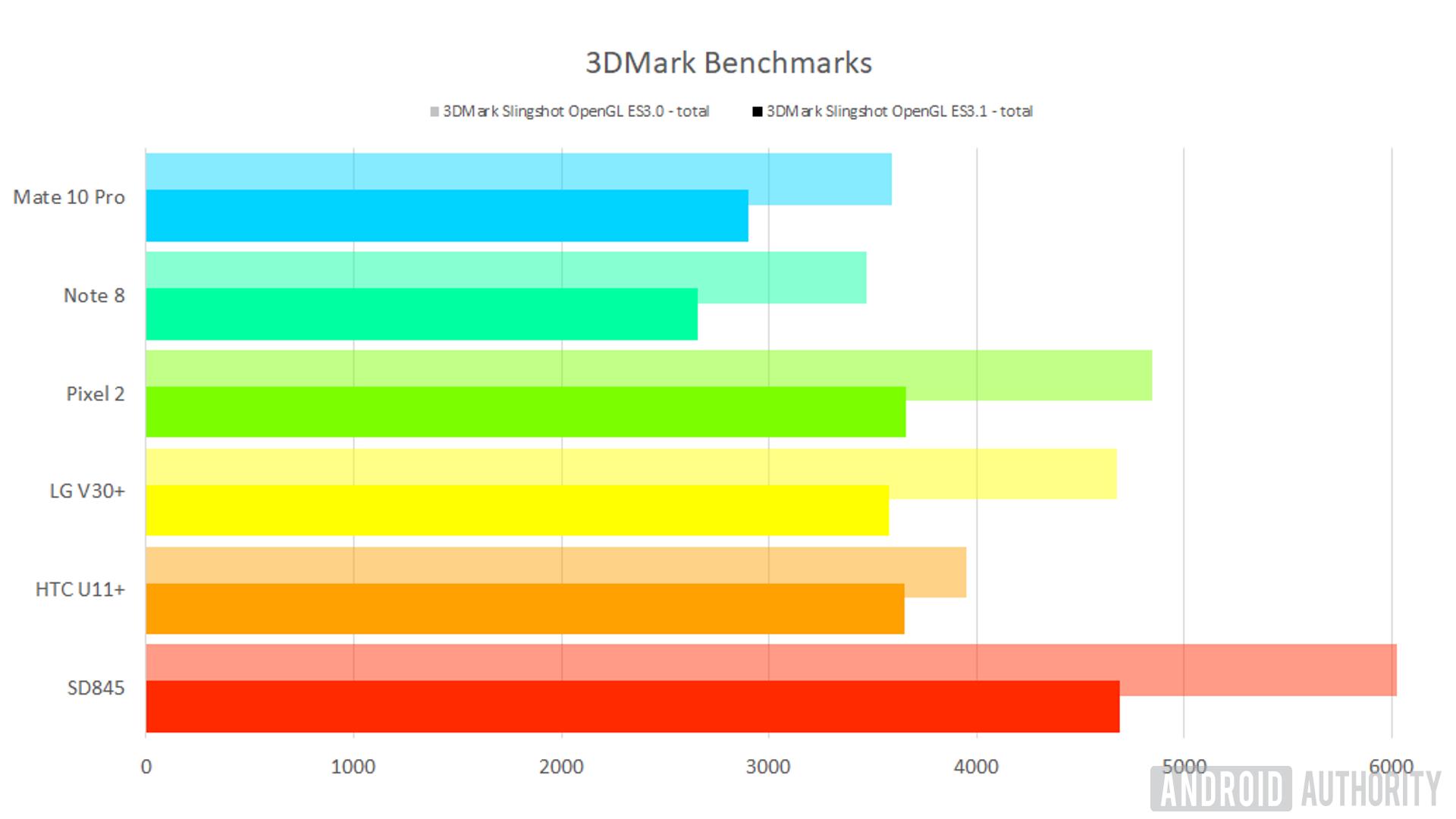
The Snapdragon 845 scores 4690 in the Slingshot Unlimited ES3.1 test and 6026 in the Slingshot Unlimited ES3.0 test. By comparison, the previous highest was the Pixel 2 which scored 3658 and 4843 for SlingShot Extreme. Since “Extreme” and “Unlimited” are different variants of the SlingShot test, we can’t accurately calculate a percentage improvement between the two versions of the processor, so these results are here for reference only and are not included in our final calculations.
Conclusion
As you might expect, the Snapdragon 845 offers considerable improvements over the Snapdragon 835 from last year, but Qualcomm also appears to have taken a considerable march over rival chipsets from both Samsung and HUAWEI. The biggest improvements don’t appear to be in the CPU, rather in the graphical prowess of the new Adreno 630 GPU.
Taking all of the results into consideration, the Snapdragon 845 appears to be 34.86% better than the respective best processor of last year in each test, and 49.38% better than the average of last year’s processors. That’s a major improvement in the processor, at least on paper. Of course, we’ll have to wait for the first devices running the Snapdragon 845 to hit the market to truly see how much better the Snapdragon 845 is.
What do you think of Qualcomm’s new architecture? Are you excited for the first Qualcomm Snapdragon 845 powered smartphones to hit the market?
Thank you for being part of our community. Read our Comment Policy before posting.